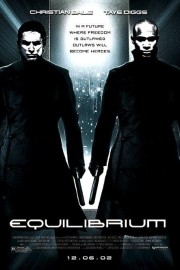Equilibrium
Kurt Wimmer’s “Equilibrium” opened in the late months of 2002, Dimension Films did not give it a ceremonious release. I remember that we had it at the theater for a few weeks, then it closed with a whimper. But those who saw the film knew they had seen a movie worth remembering. It’s the type of film fans share with people who haven’t seen it before; they tend to become new fans of the film.
At its core, “Equilibrium” is little more than Ray Bradbury’s “Fahrenheit 451” by way of “The Matrix.” At the beginning of the 21st Century, the Earth has endured World War III, but not without a cost. To prevent a fourth, scientists and governments have created a drug that inhibits emotion in humans. To enforce this, all forms of art and creativity are outlawed as well. John Preston (Christian Bale) is a cleric that enforces this new world order with ruthlessness. His wife was arrested and executed for “sense crimes” four years ago, and he and his two children (including a son who is in training to become a cleric as well) has gone on as if nothing has happened– such is the way in such a fascist society. But what happens when Preston himself feels? This will be the opportunity Preston is given when he drops his morning dose of the drug Prozium after his old partner (played by Sean Bean) is discovered to be guilty of sense crime.
The central story is as old as science fiction itself: a lone hero who sees the real inner workings of their society. Combine that with a healthy dose of Bradbury-esque social commentary and you have the very essence of what most sci-fi does: comments on the modern world by way of a universe that is artificial. As written and directed by Wimmer, best known as a writer of such genre films as “The Recruit” and “The Thomas Crown Affair” remake, “Equilibrium” finds its own style less in story than in the idea of Gun Kata, the fictional form of martial arts and gun technique that Wimmer created specifically for this film. The creativity and excitement generated from the scenes of Preston and the other clerics in action with this specific form of fighting is exhilarating. The precision of the moves; the quickness of the choreography; the fluidity of the cinematography by Dion Beebe all add to action scenes that surpass the CG-augmented “Matrix” scenes that look more fake as the years go by. In his 2006 film “Ultraviolet,” Wimmer tried to surpass this by going deeper in creating a visual landscape. The reason he failed there is the reason most other action films fail: story. Here, the visual universe matches the emotional universe he’s created in the story. In “Ultraviolet,” the two just don’t match up.
In the end though, “Equilibrium” wouldn’t work at all if the characters were as one-dimension as simple video game targets. This is another area where Wimmer excels over the Wachowski Sisters in their increasingly bloated “Matrix” films. It starts with Bale, who hinted at the Batman he would become as Preston, bringing resolve and buried humanity to a character whose past will define his future. As a resistance fighter who Preston arrests and learns more about feeling world about, Emily Watson is slumming it but finds real dimension in this strong willed character. As Preston’s politically-motivated new partner, Taye Diggs is a complicated machine of a man; how much he suspects, and how much he trusts Preston, is essential to the way his character behaves, and Diggs is successful at portraying that. And then there’s Angus MacFadyen (Robert the Bruce from “Braveheart”) as the face of the government and William Fitchner as the leader of the resistance are two sides of the same coin: people who are determined to make sure that their way of living survives the coming war. When the film has finished, we see how Wimmer has created a unique and exciting world of both intellect and emotion, which is what Preston comes to fight for. If only we gave filmmakers more freedom to follow through on their vision…even if it takes a while for that vision to find its audience.










